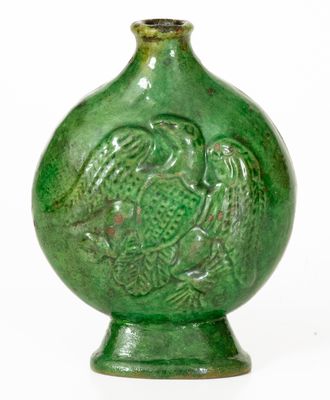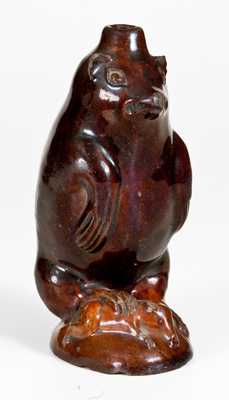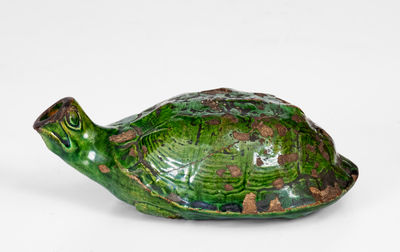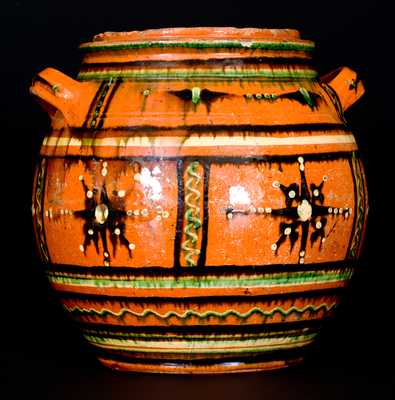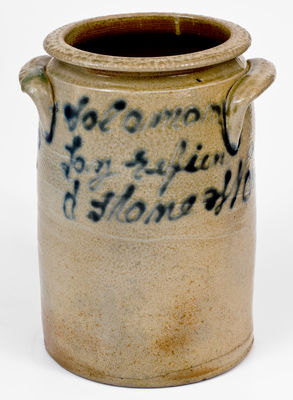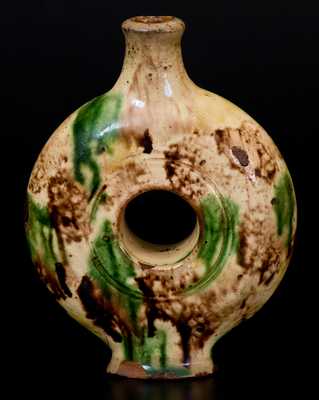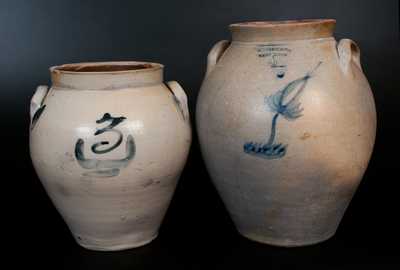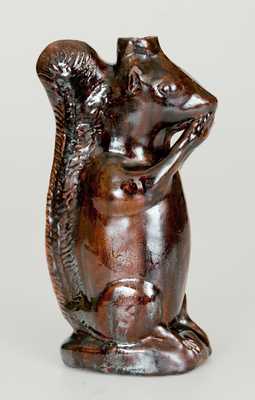Extremely Rare and Important Lidded Redware Sugar Jar with Profuse Three-Color Slip Decoration, Alamance County, NC origin, possibly Jacob Albright, Jr. and Henry Loy, circa 1790-1810, squat-shaped, ovoid jar with footed base, open horizontally-oriented handles, and original domed lid with pointed finial. Surface covered in dark manganese and profusely decorated with floral, geometric, and line designs in sea-green, orange, and white slip. Front and reverse with sunflower motifs in orange and white slip, separated by vertical orange slip lines flanking columns of green slip spots. Body of jar with circumferential bands of green, orange, and white slip. Area below handles decorated on each side with a large sunflower or daisy motif in orange and white slip. Each handle decorated with an orange and green slip flower blossom flanked by stripes. Lid heavily-decorated with alterating bands of cream, orange, and green slip, applied over dark manganese. A rare survivor, this jar is one of a small body of work recently attributed to the St. Asaph's school of potting in Alamance County, North Carolina. In the past, several examples of this style have been attributed to the Moravian potters of Salem and Bethabara, North Carolina, including Rudolph Christ and John Butner. However, recent research indicates that pieces of this distinct style were made in or around the St. Asaph's district of modern-day Alamance County, North Carolina; the entire decorative style was primarily driven by members of the Loy family of potters, working for or alongside members of the Albright family (see Beckerdite, Brown, Hunter, and Carnes-McNaughton, "Earthenware Masterworks of the St. Asaph's Tradition", Antiques and Fine Art Magazine, Winter 2010). Many of the sugar jars now in public or private collections, including this example, were purchased in North Carolina by pioneer antiques dealer, Joe Kindig, Jr., during the 1930s, and later sold through his business in York, PA. The term "sugar jar", used on many 18th and 19th century inventories, is corroborated by the fact that many of the jars Kindig found in North Carolina still contained sugar when he purchased them (see Beckerdite et al., "Earthenware Masterworks of the St. Asaph's Tradition," Antiques and Fine Art Magazine, Winter 2010). The majority of known examples of slipware from this school are currently held in museum collections, most prominently at Old Salem Museum and Gardens in Winston-Salem, NC. Others can be found at the Colonial Williamsburg Foundation in Williamsburg, VA, the Henry Ford Museum in Dearborn, MI, and the Barnes Foundation in Philadelphia, PA. Few sugar jars have entered the secondary market in recent decades, and very few can be considered new discoveries. In our research, the last instance of a slip-trailed Alamance County sugar jar of any significance selling at auction occurred at the sale of the John Gordon Collection of Folk Americana, conducted by Christie's in January 1999. Two jars crossed the block, at that time attributed to Moravian potters, both lacking their lids, with less-elaborate decoration than this jar, and neither with the striking manganese ground so distinctive to the region. Given its high aesthetic value, historical significance, and rarity, this jar is certainly one of the most important examples of North Carolina pottery to come to auction in the past decade. Provenance: This jar was recently discovered in the collection of the Pfaltzgraff Company Archives in York, PA. The Pfaltzgraff Company was a well-known producer of salt-glazed stoneware during the second half of the 19th century and art pottery and dinnerware throughout the 20th century, and a direct descendant of the Pfaltzgraff family, Helen Pfaltzgraff Appell (1900-1989), was also an early collector of Americana. Living in York, PA much of her collection, including this jar, was acquired by Joe Kindig, Jr. This jar is featured on page 96 of the book, Pfaltzgraff America's Potter, which was published in conjunction with an exhibition at the Historical Society of York County in 1989, and discussed the history of Pfaltzgraff pottery production as well as its American antecedents. The collection of Helen Pfaltzgraff Appell and her husband, Louis B. Appell, would later be sold by Sotheby's in 2003. However, the jar along with a very few other items, which were part of the 1989 exhibition, were not sold, having remained in the Pfaltzgraff Company Archives until now. Literature: Pictured on page 96 of Pfaltzgraff America's Potter, Historical Society of York County, York, PA, 1989; for discussion of Alamance County, NC redware and images of similar examples, see Beckerdite, Brown, and Carnes-McNaughton, "Slipware from the St. Asaph's Tradition", Ceramics in America 2010; see also Beckerdite, Brown, Hunter, and Carnes-McNaughton, "Earthenware Masterworks from the St. Asaph's Tradition", Antiques and Fine Art Magazine, Winter 2010. Jar with very old, possibly 19th century, plaster repairs to one handle, rim chips, and some sporadic glaze loss. Numerous small chips to edge of lid, heavy chipping to flange on underside of lid, wear to surface of lid, and a 3" hairline to lid. H (including lid) 10".










